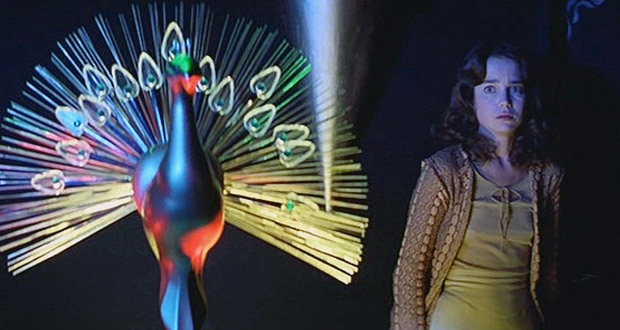« Coffee Break | Main | Two Paths »
March 13, 2018
Suspiria

Dario Argento - 1977
Synapse Films BD Region A two-disc set
As Michael Mackenzie points out in his featurette on the supplemental disc, you can only experience seeing Suspiria for the first time once. For myself, my initial viewing was during the Summer of 1977, at the Centre Theater in downtown Denver, a single screen theater designed to showcase the then new Cinemascope process with first run films from 20th Century-Fox. I had a vague idea of what I was in for, having seen Four Flies on Grey Velvet and Deep Red. There was the sense of something special about to happen when I first heard that tinkly creepy music from Goblin, and heard that whoosh of air accompanying Jessica Harper, the ends of her scarf flying against the wind, as she step out of the airport. Suspiria stayed on my mind as I bought a gray market video tape dubbed from a Japanese laser disc over twenty years later, and then pounced on the three-disc set from Anchor Bay. I followed the news about Synapse's 4K restoration, and was able to see Suspiria again on screen, a smaller screen and theater, last Labor Day. And yes, it was quite worth it to see and hear the restored version in a theater. Even for those who may have missed the 4K theatrical run of Suspiria should still find this new home version to be a treat for both eyes and ears.
As Troy Howarth mentions in his commentary track, there's always something new to notice when revisiting Suspiria. The first time, the attention is mostly devoted to the story. Suzy Bannion, a young ballet student, goes to a school near Germany's Black Forest, only to discover that the place is run by a coven of witches. The narrative aspects of Suspiria are the least weird parts of the film. The student, Pat Hingle, returns to her apartment with an impossibly ornate lobby, and a skylight that resembles Tiffany glass. A glimpse of the elevator reveals an oversized interior with a full sized cushioned bench. Above the elevator entrance is a light that resembles a glowing jewel. Interior walls are covered with ornate decorations or textured materials. Sometimes there are little bits of business that might not be noticed, like the dancer in black leotards in the background, ending a phone conversation, who seems to be slinking away as if she's avoiding being caught. And why, in 1977, is a young boy dress in the late 19th Century style of Little Lord Fauntleroy?

Do I need to tell you that this is a great looking blu-ray? Luciano Tovoli, the film's cinematographer, was on hand to make sure that the colors look as originally intended. Some scenes are monochrome, bathed in blue or red. With slo-mo and freeze frame, one can savor the textures, the details, and the use of color. If nothing else, Suspiria is one of the great examples of style. And it is no coincidence that two of the characters are named after color, Blanc and Tanner. The English language soundtrack is 4.0 surround sound, as was created for the initial release. There is the option of seeing the film in Italian, but keep in mind that stars Harper, Joan Bennett and Alida Valli all spoke English during the production, and it is their voices on the English language soundtrack.
There are two commentary tracks. Troy Howarth's was the more interesting, maybe because I heard it first, with his connecting Suspiria and the cast to other films of related interest. There were some bits of interest on the second commentary track by David Del Valle and Derek Botelho. Del Valle mistakenly states that Alida Valli was married to Fritz Lang. Also, International Classics, the distributor of Suspiria, was not created by 20th Century-Fox just for this film to cover any concerns the suit may have had about the graphic violence. A simple search in IMDb shows that International Classics was a Fox subsidiary used initially for European art house movies that were considered too adult for Fox, in the early to mid-Sixites. Titles include Roger Vadim's Please, Not Now starring Brigitte Bardot, and Luis Bunuel's Diary of a Chambermaid. I also think one of the commentary tracks should have been done by a female film critic. Suspiria was relatively unique for its time with a female character saving herself in a film where all the major characters are female, while the men here are generally in the background. Maitland McDonagh, the Argento scholar who provided the entertaining and informative commentary track for Synapse's release of Tenebrae, and also did publicity for New York City Ballet, would have been perfect. There are also the usual suspects like Samm Deighan and Kat Ellinger. Also, someone like Farran Smith Nehme would be able provide more in-depth discussion on Alida Valli and Joan Bennett, hopefully inspiring viewers to dig into the classics that inspired Argento's casting of these two actresses.
In addition to Mackenzie's piece, the second disc includes a documentary on the German locations, the making of Suspiria, and an interview with Barbara Magnolfi, the actress who appears as Olga. Even without all the supplements, what makes Suspiria continually fascinating a viewing experience is that everything that is seen was done on camera, all with practical special effects. With walls breaking and props exploding, Jessica Harper had good reason to hope she'd escape from that house of horror alive.
Posted by Peter Nellhaus at March 13, 2018 10:02 AM
